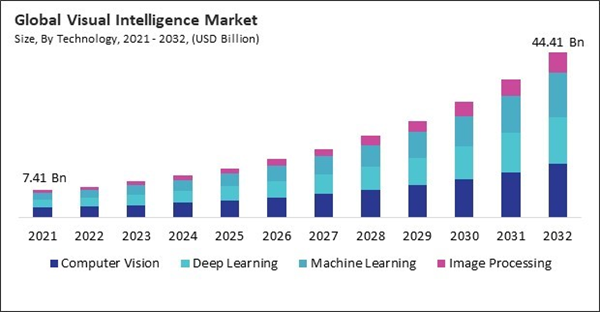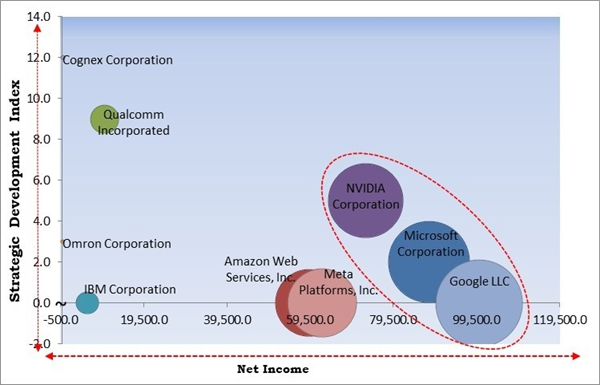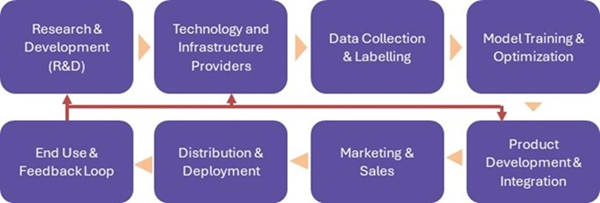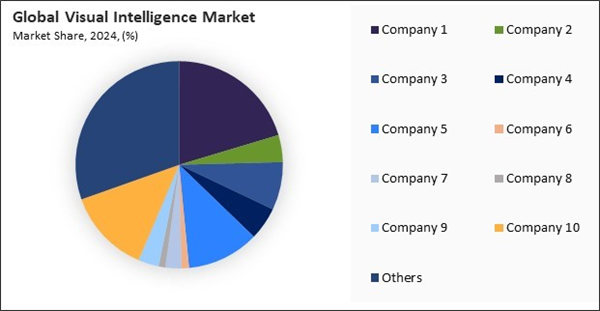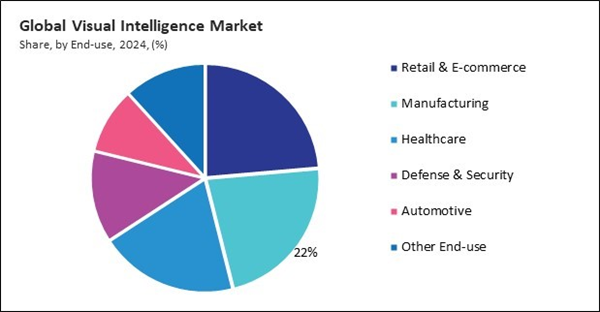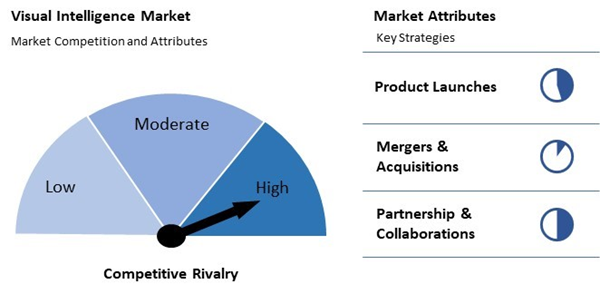Computer Vision forms the foundational layer of the global visual intelligence market, enabling machines to interpret, understand, and make decisions based on visual inputs such as images and video. As a mature and widely deployed technology, it plays a pivotal role in powering real-time applications across a broad range of industries including manufacturing, healthcare, automotive, retail, defense, and smart cities.
The major strategies followed by the market participants are Partnerships as the key developmental strategy to keep pace with the changing demands of end users. For instance, In May, 2025, Qualcomm Incorporated teamed up with Advantech, a Computer manufacturing company to advance Edge AI for IoT, integrating Qualcomm’s Dragonwing tech into Advantech’s edge platforms. This collaboration boosts AI performance across industries, supports developer tools for faster deployment, and aims to accelerate intelligent, autonomous edge solutions in robotics, manufacturing, healthcare, and more. Moreover, In February, 2025, Microsoft Corporation announced the partnership with Anduril Industries, a defense industry to advance the U.S. Army’s Integrated Visual Augmentation System (IVAS). Anduril will oversee hardware and software development, while Microsoft’s Azure cloud will power AI workloads, enhancing battlefield awareness, decision-making, and combat readiness through augmented and virtual reality technologies.
Cardinal Matrix - Market Competition Analysis
Based on the Analysis presented in the Cardinal matrix; Google LLC, Microsoft Corporation, and NVIDIA Corporation are the forerunners in the Visual Intelligence Market. In November, 2024, NVIDIA Corporation teamed up with GFT Technologies, an IT service management company partners with NVIDIA to deliver advanced AI manufacturing solutions, combining GFT’s digitization expertise with NVIDIA’s AI software and computing platforms. This collaboration enables tailored AI applications like digital twins and visual inspection tools, enhancing quality control and operational efficiency in manufacturing industries worldwide. Companies such as Meta Platforms, Inc., Amazon Web Services, Inc., and Qualcomm Incorporated are some of the key innovators in Visual Intelligence Market.
COVID-19 Impact Analysis
The COVID-19 outbreak acted as a catalyst for the visual intelligence market, driving accelerated adoption across industries. In the short term, businesses grappled with pandemic‑induced disruption and rapidly pivoted to cloud-based visual analytics and computer-vision platforms to make sense of fast-changing consumer behavior, supply chain pressures, and remote work challenges. Healthcare, especially diagnostic imaging, saw AI‑powered tools - like CT-scan analysis systems for COVID pneumonia - deployed at scale, augmenting overburdened radiologists and enabling remote patient triage. Thus, the COVID-19 had positive impact on the visual intelligence market.Driving and Restraining Factors
Drivers
- Proliferation Of Edge Computing And Iot Devices
- Advancements In Deep Learning And Computer Vision Algorithms
- Growing Demand For Automation And Operational Efficiency
- Enhanced User Experiences In Consumer Electronics
Restraints
- Data Privacy And Regulatory Compliance Challenges
- High Implementation And Operational Costs
- Shortage Of Skilled Professionals
Opportunities
- Transformation Of Healthcare Imaging And Diagnostics
- Integration Into Smart City Infrastructure And Urban Mobility
- Reinventing Retail Customer Experience And Operational Analytics
Challenges
- Generalization And Model Robustness In Real-World Environments
- Data Quality And Annotation Bottlenecks
- Ethical And Societal Implications Of Visual Surveillance
Market Growth Factors
The rapid expansion of edge computing and the Internet of Things (IoT) has significantly influenced the growth of the visual intelligence market. Edge computing allows data processing to occur closer to the data source, reducing latency and bandwidth usage. This is particularly beneficial for visual intelligence applications that require real-time data analysis, such as surveillance systems, autonomous vehicles, and industrial automation. As these technologies continue to evolve, their combined impact is expected to drive significant growth in the visual intelligence market.Additionally, the evolution of deep learning and computer vision algorithms has been a cornerstone in the development of visual intelligence technologies. These advancements have enhanced the ability of machines to interpret and analyze visual data with a level of accuracy and efficiency that was previously unattainable. Deep learning models, particularly convolutional neural networks (CNNs), have revolutionized image and video analysis by enabling automated feature extraction and pattern recognition. This has led to significant improvements in applications such as facial recognition, object detection, and scene understanding. As these algorithms become more robust and accessible, they will further accelerate the adoption of visual intelligence solutions.
Market Restraining Factors
However, The integration of visual intelligence technologies, such as facial recognition and biometric analysis, has raised significant concerns regarding data privacy and regulatory compliance. As these systems often process sensitive personal information, they are subject to stringent data protection laws like the European Union's General Data Protection Regulation (GDPR) and the California Consumer Privacy Act (CCPA) in the United States. These regulations mandate strict guidelines on data collection, storage, and usage, requiring organizations to implement robust data governance frameworks. In conclusion, while visual intelligence offers powerful capabilities, its adoption hinges on navigating complex privacy regulations, ensuring ethical use, and maintaining public trust.Value Chain Analysis
The value chain of the Visual Intelligence Market begins with Research & Development (R&D), driving innovation and foundational progress. This is supported by Technology and Infrastructure Providers, enabling scalability and efficiency. Data Collection & Labelling feeds quality inputs for Model Training & Optimization, where intelligent models are refined. These models are integrated into real-world solutions through Product Development & Integration, followed by Marketing & Sales efforts to promote adoption. Distribution & Deployment ensures reach across markets, while End Use & Feedback Loop provides critical insights, which cycle back to inform R&D and infrastructure development, completing a dynamic, iterative innovation loop.
Market Share Analysis
The leading players in the market are competing with diverse innovative offerings to remain competitive in the market. The above illustration shows the percentage of revenue shared by some of the leading companies in the market. The leading players of the market are adopting various strategies in order to cater demand coming from the different industries. The key developmental strategies in the market are Partnerships & Collaborations.
Technology Outlook
Based on the Technology, the Global Visual Intelligence market is segmented into Computer Vision, Deep Learning, Machine Learning, and Image Processing. The Deep Learning segment garnered the 29% revenue share in the market in 2024. Deep learning is a transformative segment of the global visual intelligence market, enabling systems to process and interpret complex patterns in visual data with a high degree of accuracy. Built on artificial neural networks, deep learning models mimic human cognitive processes - learning from massive datasets to detect intricate features, make predictions, and continuously improve performance.End-use Outlook
Based on the End-use, the Global Visual Intelligence market is segmented into Retail & E-commerce, Manufacturing, Healthcare, Defense & Security, Automotive, and Other End-use. The Manufacturing segment acquired the 22% revenue share in the market in 2024. The Manufacturing segment stands as a pivotal contributor to the global visual intelligence market, driven by the escalating demand for automation, quality assurance, and predictive maintenance across industrial sectors. As global manufacturers navigate increasing complexity, supply chain volatility, and labor constraints, visual intelligence technologies have emerged as a core solution to enhance operational efficiency and maintain high production standards.Application Outlook
Based on the Application, the Global Visual Intelligence market is segmented into Surveillance & Security, Quality Inspection & Automation, Facial Recognition, Image & Video Analytics, Predictive Maintenance, Traffic Monitoring, and Retail Analytics. The Quality Inspection & Automation segment recorded the 22% revenue share in the market in 2024. The Quality Inspection & Automation segment is a vital pillar of the global visual intelligence market, playing a transformative role in enhancing product reliability, operational efficiency, and manufacturing precision. As industries increasingly automate production lines to meet global demand and reduce human error, visual intelligence technologies - particularly computer vision, deep learning, and image processing - are being widely deployed to perform fast, accurate, and scalable quality checks.Regional Outlook
Region-wise, the market is analyzed across North America, Europe, Asia Pacific, and LAMEA. The North America Segment attained the 37% revenue share in the market in 2024. This growth was driven by the region's strong technological infrastructure, high adoption of advanced analytics solutions, and supportive regulatory frameworks that encouraged innovation while enforcing data protection. The presence of key market players and increased investment in AI and machine learning technologies further contributed to North America's dominant position in the global market.Market Competition and Attributes
The Visual Intelligence Market is highly competitive, driven by startups and regional firms focusing on AI-powered image and video analytics. Innovation, affordability, and niche applications in retail, healthcare, and security fuel competition. These players leverage agile development and industry-specific customization to capture market segments, creating a dynamic environment despite limited global reach and brand influence.
Recent Strategies Deployed in the Market
- Mar-2025: NVIDIA Corporation unveiled Cosmos World Foundation Models, enabling customizable physical AI reasoning and large-scale synthetic data generation for robotics and autonomous vehicles. Early adopters include Agility Robotics and Uber. The platform supports enhanced AI training through photorealistic simulations, multimodal reasoning, and real-time world generation, accelerating physical AI development.
- Feb-2025: Qualcomm Incorporated teamed up with DevisionX, a software company to advance AI computer vision solutions, integrating DevisionX’s Tuba.AI platform with Qualcomm AI Hub for seamless model deployment on Snapdragon devices. This collaboration enhances performance, reduces latency, and simplifies AI vision workflows, enabling businesses to optimize operations and scale AI vision technologies efficiently.
- Jan-2025: Qualcomm Incorporated unveiled its AI On-Prem Appliance Solution and AI Inference Suite, enabling enterprises to run generative AI and computer vision workloads locally. These tools offer cost-effective, secure AI deployment with support from industry leaders like Honeywell, Aetina, and IBM for diverse enterprise and industrial applications.
- Oct-2024: Qualcomm Incorporated teamed up with Mistral AI, an AI company to bring Mistral’s advanced generative AI models, Ministral 3B and 8B, to Snapdragon-powered edge devices like smartphones, vehicles, and PCs. This collaboration aims to enable faster, private, and energy-efficient on-device AI, enhancing user experiences with AI assistants and more.
- Apr-2024: Cognex Corporation unveiled the In-Sight L38, the world’s first AI-powered 3D vision system. It combines 2D, 3D, and AI technologies for fast, reliable manufacturing inspections. The system simplifies setup, offers high-resolution imaging with patented laser optics, and enhances quality and performance in factory automation.
List of Key Companies Profiled
- NVIDIA Corporation
- IBM Corporation
- Microsoft Corporation
- Amazon Web Services, Inc. (Amazon.com, Inc.)
- Google LLC (Alphabet Inc.)
- Omron Corporation
- Cognex Corporation
- Meta Platforms, Inc.
- Qualcomm Incorporated (Qualcomm Technologies, Inc.)
- Intel Corporation
Market Report Segmentation
By Technology
- Computer Vision
- Deep Learning
- Machine Learning
- Image Processing
By End-use
- Retail & E-commerce
- Manufacturing
- Healthcare
- Defense & Security
- Automotive
- Other End-use
By Application
- Surveillance & Security
- Quality Inspection & Automation
- Facial Recognition
- Image & Video Analytics
- Predictive Maintenance
- Traffic Monitoring
- Retail Analytics
By Geography
- North America
- US
- Canada
- Mexico
- Rest of North America
- Europe
- Germany
- UK
- France
- Russia
- Spain
- Italy
- Rest of Europe
- Asia Pacific
- China
- Japan
- India
- South Korea
- Singapore
- Malaysia
- Rest of Asia Pacific
- LAMEA
- Brazil
- Argentina
- UAE
- Saudi Arabia
- South Africa
- Nigeria
- Rest of LAMEA
Table of Contents
Companies Mentioned
- NVIDIA Corporation
- IBM Corporation
- Microsoft Corporation
- Amazon Web Services, Inc. (Amazon.com, Inc.)
- Google LLC (Alphabet Inc.)
- Omron Corporation
- Cognex Corporation
- Meta Platforms, Inc.
- Qualcomm Incorporated (Qualcomm Technologies, Inc.)
- Intel Corporation



